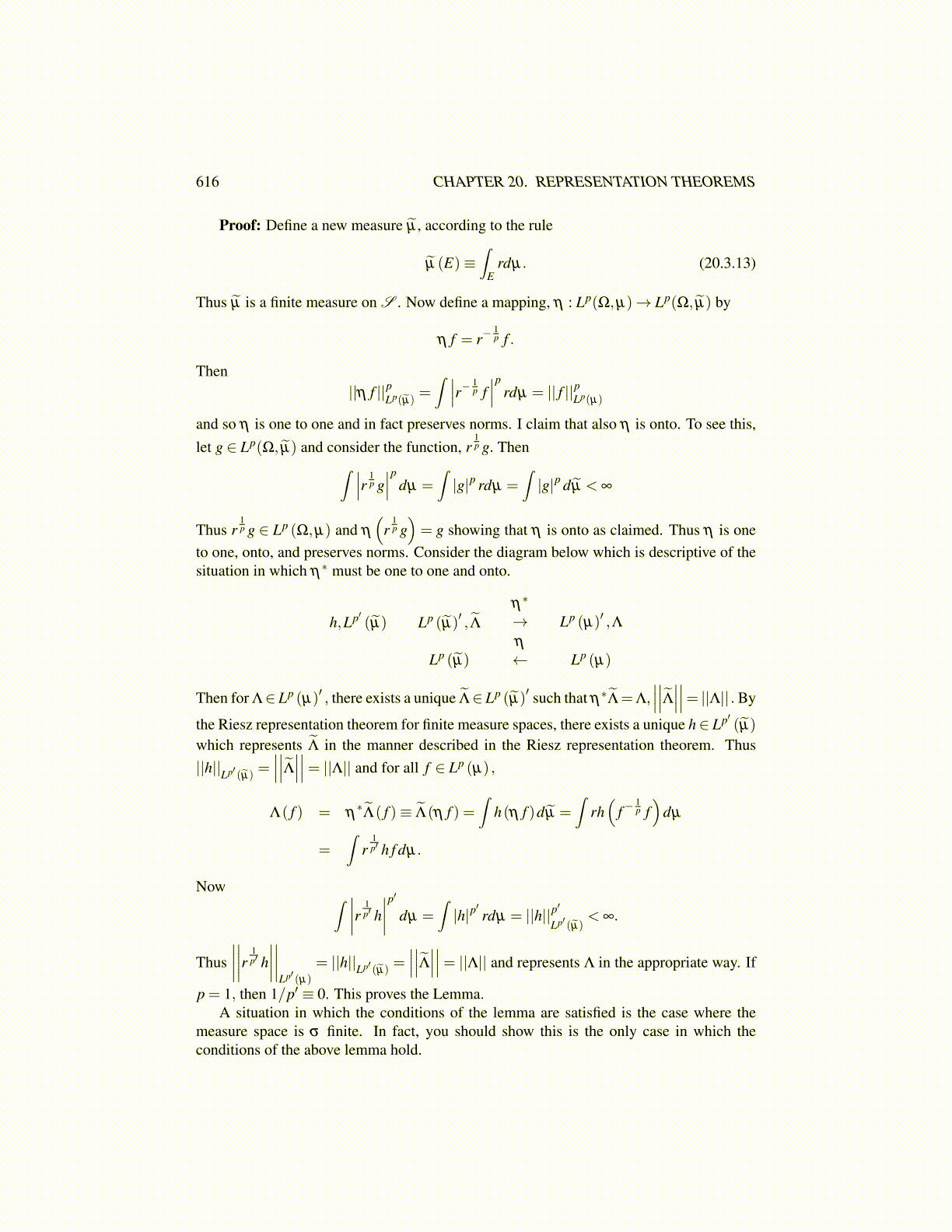
616 CHAPTER 20. REPRESENTATION THEOREMS
Proof: Define a new measure µ̃ , according to the rule
µ̃ (E)≡∫
Erdµ. (20.3.13)
Thus µ̃ is a finite measure on S . Now define a mapping, η : Lp(Ω,µ)→ Lp(Ω, µ̃) by
η f = r−1p f .
Then||η f ||pLp(µ̃)
=∫ ∣∣∣r− 1
p f∣∣∣p rdµ = || f ||pLp(µ)
and so η is one to one and in fact preserves norms. I claim that also η is onto. To see this,let g ∈ Lp(Ω, µ̃) and consider the function, r
1p g. Then∫ ∣∣∣r 1
p g∣∣∣p dµ =
∫|g|p rdµ =
∫|g|p dµ̃ < ∞
Thus r1p g ∈ Lp (Ω,µ) and η
(r
1p g)= g showing that η is onto as claimed. Thus η is one
to one, onto, and preserves norms. Consider the diagram below which is descriptive of thesituation in which η∗ must be one to one and onto.
h,Lp′ (µ̃) Lp (µ̃)′ , Λ̃
η∗
→ Lp (µ)′ ,Λ
Lp (µ̃)η
← Lp (µ)
Then for Λ∈ Lp (µ)′ , there exists a unique Λ̃∈ Lp (µ̃)′ such that η∗Λ̃=Λ,∣∣∣∣∣∣Λ̃∣∣∣∣∣∣= ||Λ|| . By
the Riesz representation theorem for finite measure spaces, there exists a unique h∈ Lp′ (µ̃)
which represents Λ̃ in the manner described in the Riesz representation theorem. Thus||h||Lp′ (µ̃) =
∣∣∣∣∣∣Λ̃∣∣∣∣∣∣= ||Λ|| and for all f ∈ Lp (µ) ,
Λ( f ) = η∗Λ̃( f )≡ Λ̃(η f ) =
∫h(η f )dµ̃ =
∫rh(
f−1p f)
dµ
=∫
r1p′ h f dµ.
Now ∫ ∣∣∣∣r 1p′ h∣∣∣∣p′ dµ =
∫|h|p
′rdµ = ||h||p
′
Lp′ (µ̃)< ∞.
Thus∣∣∣∣∣∣∣∣r 1
p′ h∣∣∣∣∣∣∣∣
Lp′ (µ)= ||h||Lp′ (µ̃) =
∣∣∣∣∣∣Λ̃∣∣∣∣∣∣= ||Λ|| and represents Λ in the appropriate way. If
p = 1, then 1/p′ ≡ 0. This proves the Lemma.A situation in which the conditions of the lemma are satisfied is the case where the
measure space is σ finite. In fact, you should show this is the only case in which theconditions of the above lemma hold.